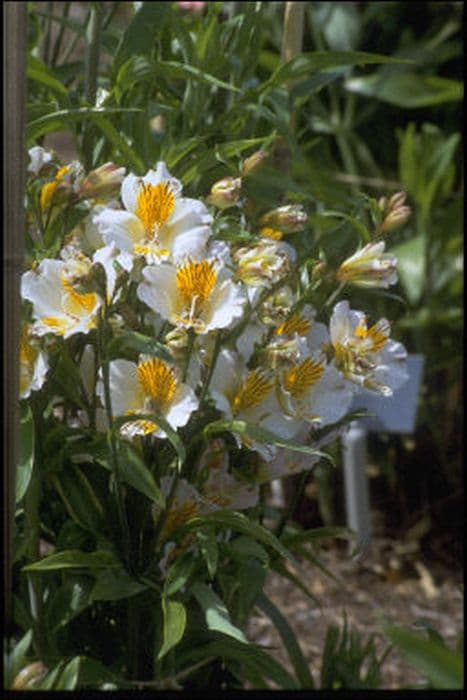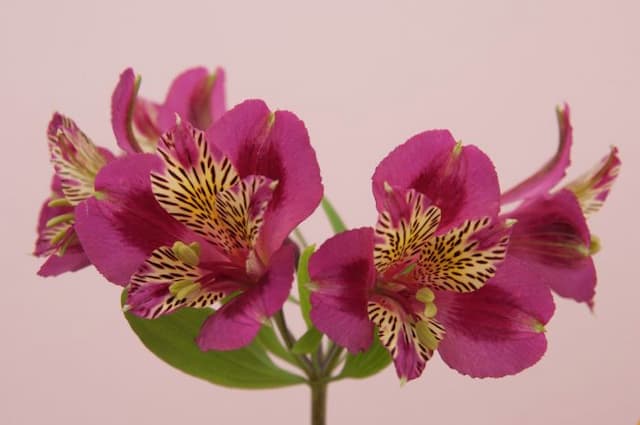Peruvian Lily Alstroemeria 'Purple Rain'

ABOUT
Alstroemeria 'Purple Rain' is a striking perennial widely admired for its vibrant and colorful flowers. The blossoms are a captivating combination of purplish hues with intricately detailed streaks and speckles that can range from dark purple to a lighter lavender or violet, often with contrasting yellow or white throats that give each flower a unique, eye-catching appearance. The petals are typically curved back upon themselves, giving them a characteristic lily-like look. These flowers are clustered in heads at the top of the leafy stems, creating a delightful display of color that is sure to attract attention. The foliage of Alstroemeria 'Purple Rain' is also quite attractive, with slender, lance-shaped leaves that have a fresh green color. The leaves may twist and turn, pointing in different directions, which creates a dynamic and textured appearance for the plant. The way the leaves clasp the stems adds further interest, giving 'Purple Rain' a distinctive look overall. With its bold blossoms and lush foliage, Alstroemeria 'Purple Rain' is a popular choice for cut flower arrangements as the blooms are long-lasting and their intense colors add drama and depth to any floral design. In a garden setting, this plant often serves as an eye-catching focal point when in bloom, bringing a splash of color to borders, beds, and containers.
About this plant
 Names
NamesFamily
Alstroemeriaceae
Synonyms
Peruvian Lily, Lily of the Incas
Common names
Alstroemeria 'Purple Rain'.
 Toxicity
ToxicityTo humans
The Alstroemeria, also known as the Peruvian lily or lily of the Incas, is considered to have a low level of toxicity to humans. However, it can cause irritation or allergic reactions in some individuals. The plant contains tulipalin, a compound which can provoke dermatitis. If ingested, parts of the Peruvian lily may lead to mild gastrointestinal discomfort, including nausea, vomiting, or diarrhea. The severity of symptoms usually relates to the amount consumed. Handling the plant may cause skin irritation, so it is advisable to wear gloves if you have sensitive skin or known allergies.
To pets
The Peruvian lily is considered mildly toxic to cats and dogs. The toxic agent in the plant, tulipalin, can cause gastrointestinal upset if ingested. Symptoms of poisoning in pets might include vomiting, diarrhea, drooling, or lethargy. These symptoms can vary in severity depending on the amount ingested. Although serious illness or death is rare, it is important to be cautious and prevent your pets from eating this plant. If you suspect your pet has ingested Peruvian lily and is showing symptoms of poisoning, contact your veterinarian for advice.
 Characteristics
CharacteristicsLife cycle
Perennials
Foliage type
Deciduous
Color of leaves
Green
Flower color
Mixed
Height
2-3 feet (60-90 cm)
Spread
1-2 feet (30-60 cm)
Plant type
Bulb
Hardiness zones
7
Native area
South America
Benefits
 General Benefits
General Benefits- Long-lasting Blooms: Alstroemeria 'Purple Rain', commonly known as Peruvian Lily, is prized for its flowers that can last up to two weeks in a vase, making it a popular choice for cut flower arrangements.
- Vibrant Color: It provides a rich purple hue to any garden or bouquet, adding a touch of elegance and vibrancy.
- Low Maintenance: Peruvian Lily is relatively easy to care for, requiring minimal maintenance once established, which is ideal for busy gardeners.
- Drought Tolerance: Once established, Alstroemeria 'Purple Rain' can tolerate periods of drought, making it suitable for gardens in drier climates.
- Bountiful Blooms: It produces an abundance of flowers from late spring to early fall, ensuring a colourful display for many months of the year.
- Attracts Pollinators: The flowers attract bees, butterflies, and hummingbirds to the garden, supporting local ecosystems.
 Medical Properties
Medical PropertiesThis plant is not used for medical purposes.
 Air-purifying Qualities
Air-purifying QualitiesThis plant is not specifically known for air purifying qualities.
 Other Uses
Other Uses- Photography Subject: Alstroemeria, also known as Peruvian lily, with its striking purple flowers can be an ideal subject for macro photography enthusiasts looking to capture the intricate details of floral patterns.
- Floral Art: The vibrant colors and unique morphology of the Peruvian lily make it a popular choice for floral art compositions and botanical illustration.
- Edible Garnish: Some people use the petals of Peruvian lilies as an unexpected, colorful garnish for salads and desserts, although they should be eaten with caution as they can cause allergic reactions in some individuals.
- Hobby Breeding: Enthusiasts of plant breeding may use Peruvian lily hybrids like 'Purple Rain' to create new varieties with distinct colorations and patterns, though this requires knowledge of plant genetics.
- Eco-Friendly Confetti: Dried petals of Peruvian lilies can be used as a biodegradable confetti alternative for celebrations to reduce environmental impact.
- Bookmark Creation: By pressing and drying the flowers of the Peruvian lily, they can be used to create unique and natural bookmarks.
- Handcrafted Jewelry: Using a process to preserve the petals, the flowers can be incorporated into resin jewelry, making for distinctive, floral-themed accessories.
- Textile Dyes: The vibrant hues of Peruvian lily petals may be used in natural dyeing processes for fabrics, although their colorfastness may vary.
- Decorative Potpourri: Dried Peruvian lily flowers can be mixed into potpourri blends for a colorful and potentially fragrant decorative accent.
- Scented Sachets: Though not known for a strong fragrance, the dried flowers and leaves of Peruvian lilies can be included in scented sachets for a subtle aroma.
Interesting Facts
 Feng Shui
Feng ShuiThe Peruvian Lily is not used in Feng Shui practice.
 Zodiac Sign Compitability
Zodiac Sign CompitabilityThe Peruvian Lily is not used in astrology practice.
 Plant Symbolism
Plant Symbolism- Friendship: The Alstroemeria, also known as the Peruvian Lily, is commonly associated with strong bonds of friendship due to its leaves that twist as they grow, symbolizing the twists, turns, and growth of friendships.
- Devotion: Representing mutual support and the dedication between friends or partners, the Peruvian Lily signifies a committed relationship.
- Wealth: With its multiple blooms per stem, the Peruvian Lily can symbolize abundance and prosperity, wishing wealth to the recipient.
- Achievement: The flowers often indicate striving to reach one's goals and are subsequently associated with hard-won success, making them ideal for congratulatory messages.
- Fortune: Blooming in a variety of colors, the Peruvian Lily can also symbolize good luck, making them a popular gift for new ventures or to wish someone fortune in their endeavors.
 Water
WaterPeruvian lily, commonly known as 'Purple Rain', should be watered regularly to maintain moist but not waterlogged soil, particularly during its blooming period in the spring and summer. Generally, aim to water once a week, providing about 1 to 1.5 gallons of water each time, depending on the climate and weather conditions. During periods of high heat or drought, you may need to water more frequently to prevent the soil from drying out. In the cooler months or if you're in a region with frequent rains, reduce the frequency of watering. Ensure good drainage to avoid root rot.
 Light
LightPeruvian lily thrives in full sun to partial shade. The best spot for the plant would be where it can receive at least 6 to 8 hours of sunlight each day, ideally morning sun with some afternoon shade, particularly in hotter climates. They can tolerate full sun in cooler regions but will need protection from intense midday sunlight in warmer areas to prevent foliage from scorching.
 Temperature
TemperaturePeruvian lilies prefer temperatures in the range of 65 to 75 degrees Fahrenheit but can endure minimum temperatures down to around 23 degrees Fahrenheit for short periods. Extended exposure to temperatures below freezing can damage the plant. Ideally, to encourage thriving growth and flowering, keep the plant in an environment that doesn't frequently dip below 50 degrees Fahrenheit or exceed 80 degrees Fahrenheit.
 Pruning
PruningPeruvian lily benefits from pruning to encourage bushiness and more blooms. Prune spent flowers regularly to promote continuous blooming and prevent the plant from putting energy into seed production. The best time for pruning is after the blooming cycle, usually in late summer or fall. Cut back the stems that have finished flowering to just above ground level, as new growth will emerge from the base.
 Cleaning
CleaningAs needed
 Soil
SoilPeruvian lilies thrive in well-draining soil enriched with organic matter, a soil pH between 6.0 to 7.0 is ideal for Alstroemeria 'Purple Rain'. A mixture of two parts garden soil, one part peat moss, and one part perlite or sand can create favorable conditions for root health and growth.
 Repotting
RepottingPeruvian lilies should generally be repotted every two to three years or when the pot becomes crowded. This ensures that Alstroemeria 'Purple Rain' has enough room for root expansion and access to fresh nutrients.
 Humidity & Misting
Humidity & MistingPeruvian lilies prefer moderate humidity levels. While they can adapt to average home humidity, ensuring that Alstroemeria 'Purple Rain' has a humidity level of 40-60% will encourage healthy growth.
 Suitable locations
Suitable locationsIndoor
Ensure bright light, well-draining soil, and occasional feeding for 'Purple Rain'.
Outdoor
Plant in well-drained soil, full sun to partial shade, protect from strong winds.
Hardiness zone
7-10 USDA
 Life cycle
Life cycleThe Alstroemeria 'Purple Rain', commonly known as Peruvian Lily or Lily of the Incas, starts its life cycle from division or tuberous rhizomes. Once planted, these rhizomes will sprout into shoots and begin to form roots and leaves, marking the vegetative growth stage. The plant will mature and enter the reproductive stage, typically in late spring or early summer, producing distinctive purple and white patterned flowers that attract pollinators. After pollination, the plant may produce dry capsules containing seeds, although Alstroemeria is commonly propagated vegetatively. In the fall, the Peruvian Lily enters a dormant phase, where the above-ground foliage dies back with the onset of cooler temperatures and the plant conserves energy in the rhizomes. In the following spring, the cycle recommences as temperatures rise and new growth emerges from the rhizomes, continuing the annual cycle of growth and dormancy.
 Propogation
PropogationPropogation time
Spring-Early Summer
Propogation: Alstroemeria 'Purple Rain', commonly known as the Peruvian Lily or Lily of the Incas, is best propagated in the spring through division, which allows the plant to recover during the growing season. To propagate by division, carefully lift the clump from the soil using a shovel or fork, ensuring you have a substantial amount of the root system on each division. Gently tease apart the rhizomes, which are the thickened roots, ensuring that each section has at least one shoot or eye for potential growth. Replant the divisions immediately at the same soil depth they were originally growing, spacing them about 24 inches (approximately 60 centimeters) apart to give ample room for spreading. Water the newly planted divisions thoroughly to help establish them. This method stimulates new growth and helps to rejuvenate older plants, allowing gardeners to expand their displays of this vibrant and colorful perennial.





![Peruvian lily [H.R.H. Princess Alice]](/_next/image?url=https%3A%2F%2Fplants-admin.emdemapps.com%2Fimages%2Fplants%2F%2Fimages%2F604b55e81c8b0.png&w=640&q=75)

![Peruvian lily [Inca Coral]](/_next/image?url=https%3A%2F%2Fplants-admin.emdemapps.com%2Fimages%2Fplants%2F%2Fimages%2F604b5b79b85ce.png&w=640&q=75)
![Peruvian lily [Inca Exotica]](/_next/image?url=https%3A%2F%2Fplants-admin.emdemapps.com%2Fimages%2Fplants%2F%2Fimages%2F604b5ec0e34a9.png&w=640&q=75)
![Peruvian lily [Inca Milk]](/_next/image?url=https%3A%2F%2Fplants-admin.emdemapps.com%2Fimages%2Fplants%2F%2Fimages%2F604b5f14b0b6a.png&w=640&q=75)